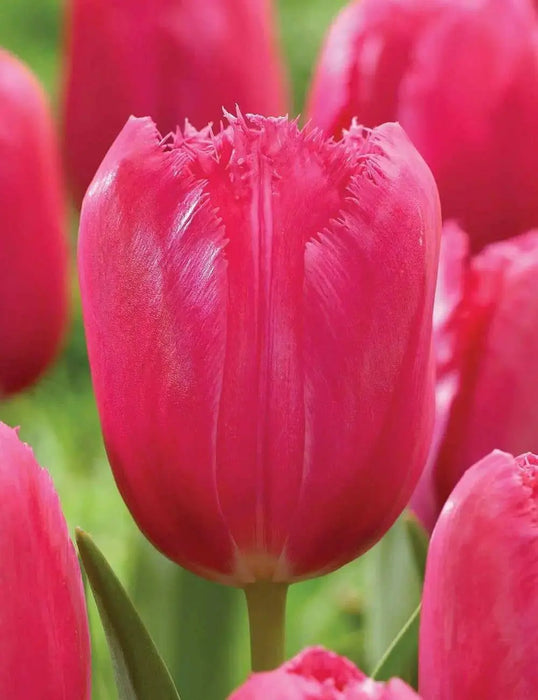
burgundy lace tulip bulbs, Shipping now!
FAST & FREE SHIPPING
Over 90% of our orders are processed and ship out by next business day.
We are currently processing and shipping most orders within 1-3 business days. (backorders not included) Due to high demand during the peak months of January to May, orders may require additional time for packaging /shipment.
Free shipping for orders over $54.95. Excludes live plants, fresh products And Stackable Black Plastic Nursery Crate
Shipping and handling charges will cover outbound freight and packaging materials. Fees are applicable to all orders, based on total order value pre-tax. Expedited services can be selected at Checkout with extra fees.
- Free shipping to lower 48 states on orders $54.95+
- (Most Items), excluding live plants, plant bulbs, and black plastic nursery crate.
- Safe Seed Pledge
- Satisfaction Guaranteed
- Select your desired size and/or color from the available options.
Fall Planting Bulbs
- Position: full sun
- Soil: fertile, well-drained soil
- Rate of growth: average
- Flowering period: May
- Hardiness: fully hardy
-
Bulb size: 11/12
A wonderful tall tulip that is a really luscious shade of burgundy. It looks great when teamed up with other bruised tones, or just planted in great swathes throughout the border. The fringed petals give the flowers an interesting silhouette.
- Garden care: In September to December plant bulbs 15-20cm deep and 10-15cm apart in fertile, well-drained soil. Alternatively, allow 7-9 bulbs per 30cm sq. After flowering deadhead and apply a balanced liquid fertiliser each week for the first month. Once the foliage has died down naturally lift the bulbs and store in a cool greenhouse.
- Harmful if eaten/may cause skin allergy
Outdoor Beds
Find a location where the soil drains well. If there are still puddles of water 5-6 hours after a hard rain, scout out another site. Or amend the soil with the addition of organic material to raise the level 2 - 3 inches to improve the drainage. Peat moss, compost, ground bark or decomposed manure all work well and are widely available.
Plant your tulips where they will get full sun to light shade. Keep in mind that for tulips to return in subsequent springs they will need a period of winter cooling. This happens easily in northern areas and will occur to the cooler parts of zone 8. (Some bulb sellers suggest that tulips will return after growing the year round warmth of zone 9. Sadly, it's just wishful thinking.)
Plant tulips 5" apart and 6" to 7" deep at the base. Deeper planting depths are better in colder regions. Position the bulbs with the pointy end facing up.
After planting, water well once, gently soaking the soil to settle it around the roots. Roots will form in the autumn. Foliage and flowers will develop in the spring.
When in bloom, feel free to cut tulips for striking bouquets.
After blooming has finished for the season leave the foliage in place; don't cut it off. The leaves will gather sunlight, create food through photosynthesis and strengthen the bulb for the future. Water as needed during active growth periods; about 1" of moisture per week is a good estimate.
By the early summer the leaves will yellow and die back. The dried foliage may be removed at this point. Your bulbs will rest until next spring when they'll beginning the next growing cycle. When leaves are absent and the bulbs are dormant, withhold water.
Pots, Barrels, Tubs & Urns
Start with containers of good quality, well-drained soil. Tulips that sit in water logged soil will rot. Shorter varieties usually perform better in all but the largest containers.
Plant your tulips where they will get full sun to light shade. Keep in mind that for tulips to return in subsequent springs they will need a period of winter cooling. This happens easily in northern areas and will occur to the cooler parts of zone 8. (Some bulb sellers suggest that tulips will return after growing the year round warmth of zone 9. Sadly, it's just wishful thinking.)
Plant tulips 4" apart and 6" to 7" deep at the base. Deeper planting depths are better in colder regions. Position the bulbs with the pointy end facing up.
After planting, water well once, gently soaking the soil to settle it around the roots. Roots will form in the autumn. Foliage and flowers will develop in the spring.
When in bloom, feel free to cut tulips for striking bouquets.
After blooming has finished for the season leave the foliage in place; don't cut it off. The leaves will gather sunlight, create food through photosynthesis and strengthen the bulb for the future. Water as needed during active growth periods; about 1" of moisture per week is a good estimate.
By the early summer the leaves will yellow and die back. The dried foliage may be removed at this point. Your bulbs will rest until next spring when they'll beginning the next growing cycle. When leaves are absent and the bulbs are dormant, withhold water.
Select your desired size and color from the available option
HOW TO GROW GUIDE
LET OUR CUSTOMER SPEAK FOR US

![[Seeds] - Caribbeangardenseed](http://caribbeangardenseed.com/cdn/shop/files/gift-card-gift-card-1_1024x1024_dfa857db-9150-4315-a362-7f0bb3fb9c47_60x28.png?v=1722895789)








